|
Combat Chart
Overview
Shell Hits - Danger Zones - Miscellaneous Damage -
Flooding - Critial Effect
Fire Control - Torpedo Hits - Uneven Flooding & Sinking - Damage Control -
Weapon Position
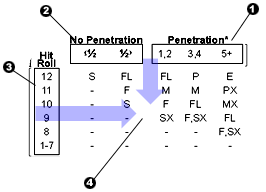
Shell Hits Chart - Compare the appropriate penetration value of the
incoming rounds to the appropriate armor value of the target vessel. If the
penetration value is higher than the armor value, the round may be able to
penetrate and the Penetration portion of the chat is used (number one).
If the penetration value is equal to or lower than the armor value, there is no
penetration and the No Penetration portion of the chart is used (number
two). Note that the left half of the No Penetration section is for shells
whose penetration value equal to or less than the armor value they are
striking. The right half is used for non-penetrating rounds whose penetration
value is still greater than half the value of the defending armor.
Roll one 12 sided die on the Shell Hit Chart for each round fired into a
vessel's target zone during the turn. Cross index each die number rolled
(number three) with the previously established Penetration column to
find the code for the damage inflicted (number four). Note that
one-third of all shells landing in a target zone will not strike the ship, or
at least will not do damage with is considered dangerous to the vessel. Shells
are rolled for in sets by ship and shell size; for example, if a ship
has four main rounds and 14 secondary rounds landing in a target zone, it will
roll one set of four dice for the mains, and another set of 14 dice for the
secondaries. Rolling in sets prevents "ganging" of die rolls (See Bonus Rolls
below).
Bonus Roll: If a player rolls doubles within a
set of penetration die rolls of eight through twelve, an extra die roll
on the Misc Damage Chart is added to the damage hits. Any additional identical
numbers add one to the total; i.e. - triples result in two Misc Damage rolls,
etc.
Shell Hit Example: A 12 inch gun turret with a penetration
index of 18-14-10 fires a medium range broadside shot at a battleship with 12-9
armor. The shell penetration will be 14, and the battleship armor will be 12,
hence a two point penetration. Use the 1,2 column of the Penetration section
and roll two 12 sided dice. If a 3 and 10 are
rolled, the target battleship suffers one fire. If two 12s are
rolled, the battleship suffers two flood hits and also must roll for an
additional bonus doubles hit on the Misc Damage Chart. |
| |
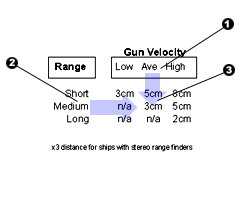
Danger Zones - The danger zone is a real life effect
due to the combination of shell trajectory and ship height. In order to
establish the danger zone of a particular target in Battlefleet 1915,
cross-index the known velocity of the firing gun type (number one) with
the distance to the leading edge of the target vessel or its base (number
two). The danger zone is the resulting value shown at the center (number
three), and equals the distance beyond the leading edge of the target
vessel within which hit zones may still be achieved. |
| |
| Miscellaneous
Damage Chart - When required to roll on the Misc Damage Chart, roll one 12
sided die (1D12), and match the number rolled with the damage code shown under
Effects. Apply that damage code and any after-effects to the vessel in
question. |
| |
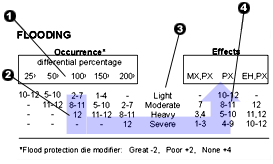
Flooding - The Occurrence section's differential percentages relate
weapon size versus target vessel size (number one). When required to
roll on the Flooding Chart, roll one 12 sided die and apply its value to the
occurrence section of the chart (number two). Apply the resulting
flood effect, if any (number three) to the randomly selected flood
compartment on that vessel's Ship Log. If a flood effect resulted from the
occurrence roll, then roll another die for the corresponding line of the
effects section (number four) and apply the appropriate damage
hits to the vessel in question.
Example: A size-60 round hits a
size-55 battleship and scores an FL result. Because the size of the shell is
100 percent or greater than the target vessel, a die is rolled on the 100>
column with a result of 8, causing moderate flooding on the
battleship. After randomly assigning the location of the flooding, another die
roll is made on the Moderate flooding line with a 9 result,
causing an PX hit ( propulsion box destroyed) to the battleship. Note that a
shell may not inflict any flooding if its size rating is less than one-quarter
of the size rating of the target vessel. |
|
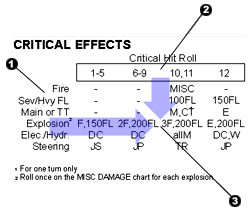
Critical Effects- There are two types of critical effects; cyclic
and static. Cyclic effects are part of the basic fire and flood rules. Their
ongoing presence on board a vessel constantly threatens to spiral out of
control. Static effects are damage events which cause various types of specific
damage all at once. Explosions, electric/hydraulic damage, steering
malfunctions and complications to main armament/torpedo hits all constitute
static critical effects.
To conduct a critical effects roll, roll one
die and cross-reference its value to the applicable critical effects line.
Apply the results called for (if any). Note that damage caused by a single
critical effect can trigger a "domino line" of damage, resulting in several
rounds of critical effect die rolls. |
|
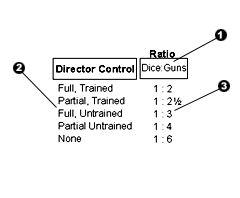
Fire Control - The fire control rating of a vessel
represents its ability to focus the firepower of its heavy guns into a tight
pattern, especially at longer ranges. For game play, the fire control rating
effects how many dice a player may roll on the Shell Hits chart by establishing
a ratio of "guns to dice." Compare the fire control rating of a vessel with the
adjoining values shown to its right. That value indicates how many guns are
required to "create" one die roll on the Shell Hit Chart. The guns in question
must be drawn from those weapons scoring viable hit zones that turn, and
may not include misses or "splashes."
For example, a British
battlecruiser with eight guns, Full director control and a Trained crew would
be able to roll four dice on the Shell Hits chart. A German battleship with ten
guns, Partial director control and a Trained crew would also be able to roll
four dice on the Shell Hits chart. An American pre-dreadnought with four guns,
Partial director control and an untrained crew would only be able to roll one
die on the Shell Hits chart. |
|
Torpedo Hits
- The Torpedo Hit Chart cross-indexes the relative courses of the launching and
target vessels (number one) with the orientation of the target
(number two). The resulting value is that required to score a hit using
a 12 sided die (number three).
Target Definitions: Two
vessels are converging if their combined courses are carrying them towards each
other. If either vessel if moving away from the other in any way, they are
considered to be on diverging courses. A good way to establish this is to look
at the miniatures and see if they are pointing towards or away from each other.
If either model points away from the other, however slightly, then it is a
diverging course. Any torpedoes fired from within a target vessel's front of
rear arc is considered a rake shot. A beam shot is any torpedo fired from
within either of a target vessel's beam arcs.
The Stationary with
nets line of the Torpedo Chart is only for vessels designated by a scenario
as being in a harbor or bay anchorage, and may not be used by any vessels
conducting combat in a seaway or other open area. |
|
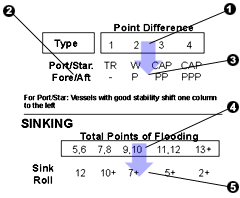
Uneven Flooding & Sinking - Vessels which
experience uneven flooding are subject to increasingly severe side effects.
Take the total difference in points between opposing vessel compartments
(number one) and cross index it with the type of the flooding (number
two). The resulting damage hits (number three) are cumulative and
remain in effect until the vessel sinks or the flooding disparity is reduced by
counter-flooding. Note that damage hits inflicted specifically as a result of
uneven flooding may not be "repaired" during normal damage control. They will
however, be eliminated or reduced if the uneven flooding condition is
eliminated or reduced.
If required to roll for possible sinking due to
flooding, locate the value on the Total Points of Flooding column which
corresponds with the total flooding points present on a vessel (number
four) and roll one 12 sided die. If the number rolled falls within the
corresponding range called out under Sink Roll (number five), the vessel
has begun to sink. (See the Sinking portion of the Damage section.) |
| |
| Damage
Control- The values shown on the Damage Control Chart are those which need
to be rolled on a 12 sided die in order to repair damage to the corresponding
damage types. Note that each "damage slash" requires a separate die roll, and
that one feature with multiple damage cannot be repaired in a single roll.
|
| |
| Weapon
Positions - This reference chart allows players to rapidly access basic arc
of fire for the various weapons on board a WWI era warship. Note that some
vessels at this time used older style weapon placement, and that player may
need to consult a Battlefleet 1900 weapon position diagram in order to
establish arcs of fire for those older warships. |
|

